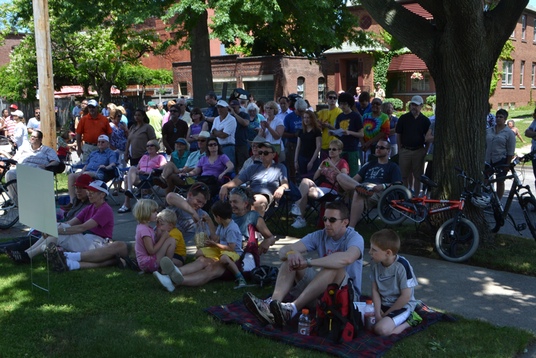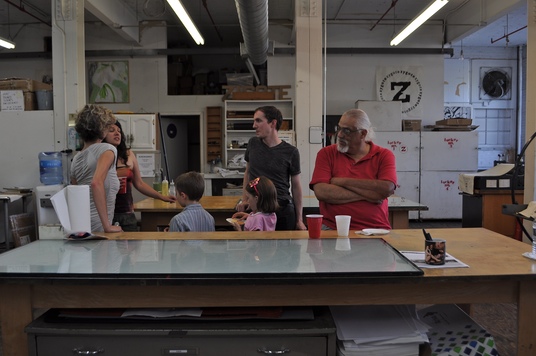
In 2006, Cuyahoga County went from one of the country’s least supportive regions for the arts to one of its most supportive virtually overnight. The reason? That year, it passed a 30-cents-a-pack tax on cigarettes to fund the arts organizations, artists, and special arts and culture events that are one of the area’s true strengths.
Everyone knew a cigarette tax was not ideal especially given the virtual inevitability of a revenue decline over time. But a small property tax had failed on the ballot a couple of years earlier, and other options were limited by law.
Despite that revenue drop as fewer people in the county smoke, the tax still raises more than $15 million a year. It’s distributed to groups as large as the Cleveland Orchestra and the Cleveland Museum of Art and as small as the Ukrainian Music & Archives or the Brecksville Theater on the Square.
The money has also gone to individual artists and to organizations for special projects such as the annual Larchmere Porchfest pictured above, where thousands of people of all ages flock to the neighborhood near Shaker Square for an afternoon of free music performed by local musicians on people’s porches. There’s no question it’s done a world of good, and that many of the smaller arts groups would not have weathered the post-2008 recession without it.
That tax is now up for renewal, with the political action committee, which got it passed in 2006, re-forming to aim for the November ballot this year.
Things have changed since 2006 — a lot. The terrain for the tax’s renewal is rocky for a number of reasons. Cuyahoga County still struggles with the aftermath of that recession, which challenged many family budgets during times of unemployment. And it is feeling the weight of state policies that have slashed funding to local governments, forcing property tax levies and income tax increases in numerous communities.

Now things at the state level could be getting worse. Governor John Kasich has just proposed his new budget, which needs to be passed by June 30, and it’s jaw-dropping. When the recession hit, his predecessor Ted Strickland tightened the state belt and cut spending from about $56 billion to $50.5. When Kasich came into office he promptly restored the previous level, then in his second budget jacked it up to $62 billion. He’s now proposing a massive spending increase to $72 billion, along with a cut in the state income tax — which means a whole lot of tax increases elsewhere.
One of the ones he’s proposing is a dollar increase in the cigarette tax. Whether this gets past the legislature remains to be seen, but if Kasich doesn’t rein in his big-spending ways, they’re going to have to find the money somewhere. Such an increase in the state cigarette tax would certainly gin up resistance to the county tax.
That could be offset by the possibility that the type of people who smoke are less likely to go to the polls in an off-off year election than those most passionate about the arts. It’s a tricky equation.
There’s also been some sentiment expressed that a cigarette tax in inherently unfair, that this tax hits those who can least afford it to pay for an elite activity. There’s some truth to the former part but little to the latter. This tax benefits lower income citizens in the area far more than the tax collected to pay for professional sports teams. Many of the groups who receive funding — the ones most likely to have folded without it —have a mission to serve poorer communities.

And most of the area’s bigger institutions provide copious programming for families and children who might otherwise not have been able to enjoy it. There’s hardly a group on the list that doesn’t do some type of outreach to struggling communities. In light of the cuts to arts programs in schools, organizations like Roots of American Music — one of the tax’s beneficiaries — whose mission is to use music to get kids in underserved communities excited about education, are more essential than ever.
And unlike the sports tax, the community directly benefits from money paid out. While much of the money spent on sports teams leaves with high-paid players who live in Arizona or Florida, virtually every person who works at a local arts organization, from Cleveland Orchestra members to a freelance costumer hired to do a show at the Beck Center, lives in the county and spends their salary here, circulating those taxes locally. That’s fueling jobs in our backyard.
If the renewal of the arts tax were to fail, it would be tragic for the region, causing many dominoes to fall and one of the area’s most attractive assets to wither. Cleveland’s endlessly mediocre sports teams are unlikely to attract many out-of-towners. But the area is widely known for its multitude of big and small arts organizations, offering everything from wheelchair dancers to big band jazz to hands-on printmaking to free festivals. Those give the area a distinctive flavor that is essential to retain. Without them, the endless “wait for next year” would be bleak indeed.
2 Responses to “The Arts Tax Comes Up for Renewal This Fall. Will the County Support Its Arts Scene?”
David Gray
You wrote, “In 2006, Cuyahoga County went from one of the country’s least supportive regions for the arts to one of its most supportive virtually overnight”
Do you mean least supportive in terms of tax-based funding? If so, please specify.
Residents of Cuyahoga County have a long history of being very supportive of the arts–through private, corporate, and foundation donations. It’s hard to believe an assertion that the region is below average in that regard, let alone “one of the country’s least supportive.”
Pat Ballasch
If you want an arts tax try taxing soft drinks. It’s more inclusive. Going after the 20% of adults that smoke requires them to do the heavy lifting for arts funding. Voting for a minority to support the arts (in my opinion) was a cheap shot at punishing smokers. (I don’t smoke personally). To me it’s about being fair.